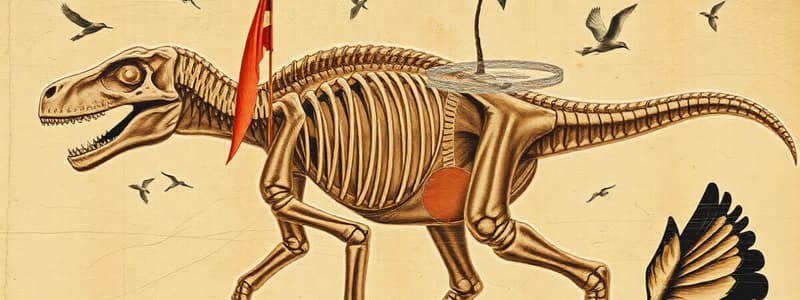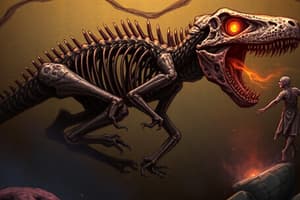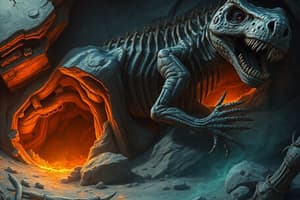Podcast
Questions and Answers
What is the term for the study of fossilized organisms, their life, and their environments?
What is the term for the study of fossilized organisms, their life, and their environments?
- Geochronology
- Sedimentology
- Paleoecology (correct)
- Taphonomy
Which of the following represents physical remains in the context of fossils?
Which of the following represents physical remains in the context of fossils?
- Shells and bones (correct)
- Mineral replacements
- Tracks and trails
- Biomarkers
In the hierarchical classification of life, which level comes directly after Kingdom?
In the hierarchical classification of life, which level comes directly after Kingdom?
- Domain
- Family
- Class
- Phylum (correct)
What does Taphonomy primarily study?
What does Taphonomy primarily study?
Which of the following provides evidence of prehistoric life, qualifying it as a fossil?
Which of the following provides evidence of prehistoric life, qualifying it as a fossil?
What is the primary process involved in mummification?
What is the primary process involved in mummification?
What condition is most conducive to the preservation of altered soft parts?
What condition is most conducive to the preservation of altered soft parts?
What term describes rich fossil deposits with exceptional preservation?
What term describes rich fossil deposits with exceptional preservation?
Which mineral is commonly found unaltered in the hard parts of brachiopods and Paleozoic corals?
Which mineral is commonly found unaltered in the hard parts of brachiopods and Paleozoic corals?
Which of the following organisms typically have hard parts made of aragonite?
Which of the following organisms typically have hard parts made of aragonite?
What is the process where the crystal structure of a mineral changes without altering its chemical composition?
What is the process where the crystal structure of a mineral changes without altering its chemical composition?
What is left behind after volatile elements are removed from a fossil due to heat and pressure in carbonization?
What is left behind after volatile elements are removed from a fossil due to heat and pressure in carbonization?
What process involves the infilling of the pores in a skeleton with minerals that precipitate out of fluids?
What process involves the infilling of the pores in a skeleton with minerals that precipitate out of fluids?
Which mineral commonly replaces original skeletal material in fossils through the process of replacement?
Which mineral commonly replaces original skeletal material in fossils through the process of replacement?
Under what environmental conditions does pyrite form during the replacement process in fossils?
Under what environmental conditions does pyrite form during the replacement process in fossils?
What type of fossil is formed when the original shell dissolves away, leaving a void?
What type of fossil is formed when the original shell dissolves away, leaving a void?
Which type of fossil mold preserves only internal features of the organism?
Which type of fossil mold preserves only internal features of the organism?
Which type of fossil mold provides a full replica of both internal and external features?
Which type of fossil mold provides a full replica of both internal and external features?
What are fossilized bacterial structures built by cyanobacteria called?
What are fossilized bacterial structures built by cyanobacteria called?
In what type of environment are stromatolites commonly formed?
In what type of environment are stromatolites commonly formed?
What are tracks, trails, and burrows examples of?
What are tracks, trails, and burrows examples of?
Which of the following is a role of endosymbionts in larger foraminifera?
Which of the following is a role of endosymbionts in larger foraminifera?
Which of the following test types involves the foraminifera taking particles and gluing them together?
Which of the following test types involves the foraminifera taking particles and gluing them together?
What is the structure of crystals in the Hyaline test type?
What is the structure of crystals in the Hyaline test type?
Which foraminifera group lacks a test and, as a result, has a poor fossil record?
Which foraminifera group lacks a test and, as a result, has a poor fossil record?
From what time period are the Texturlariida?
From what time period are the Texturlariida?
What key feature defines the Fusulinina?
What key feature defines the Fusulinina?
During which period did the planktonic Globigerinida emerge?
During which period did the planktonic Globigerinida emerge?
What type of test is characteristic of the Textulariina?
What type of test is characteristic of the Textulariina?
What is a notable characteristic of foraminifera belonging to the Fusulinina?
What is a notable characteristic of foraminifera belonging to the Fusulinina?
Which foraminifera group is known for its distinctive coiling pattern and porcelaneous test?
Which foraminifera group is known for its distinctive coiling pattern and porcelaneous test?
What are coprolites?
What are coprolites?
What is the term for chemical evidence of past life?
What is the term for chemical evidence of past life?
What organic compound, derived from bacterial cell walls, can be found as a biomarker?
What organic compound, derived from bacterial cell walls, can be found as a biomarker?
What is the study of the processes that occur from the death of an organism to its final burial?
What is the study of the processes that occur from the death of an organism to its final burial?
What process involves the removal of joints in a deceased organism?
What process involves the removal of joints in a deceased organism?
Through what process can complete arthropods and echinoderms be preserved?
Through what process can complete arthropods and echinoderms be preserved?
What is the term for wear on fossils caused by transport?
What is the term for wear on fossils caused by transport?
What term describes fossils found in the same environment they lived in?
What term describes fossils found in the same environment they lived in?
What is the term for fossils from older rocks mixed with new sediments?
What is the term for fossils from older rocks mixed with new sediments?
What factor controls a species' presence and abundance in an ecosystem?
What factor controls a species' presence and abundance in an ecosystem?
Which of these is considered a metabolic factor affecting paleoecology?
Which of these is considered a metabolic factor affecting paleoecology?
What is the term for organisms that live on the surface of a sediment?
What is the term for organisms that live on the surface of a sediment?
What characteristic makes some fossil groups useful markers for short geological time periods?
What characteristic makes some fossil groups useful markers for short geological time periods?
What is a key advantage of pelagic organisms in the context of fossil records?
What is a key advantage of pelagic organisms in the context of fossil records?
What part of a cephalopod shell regulates buoyancy?
What part of a cephalopod shell regulates buoyancy?
What is the outermost organic layer of a molluscan shell called?
What is the outermost organic layer of a molluscan shell called?
What evolutionary trend is observed in cephalopod shells during the Ordovician period?
What evolutionary trend is observed in cephalopod shells during the Ordovician period?
What kind of coiling do most living and fossil cephalopods exhibit?
What kind of coiling do most living and fossil cephalopods exhibit?
What function did chambered shells provide for cephalopods?
What function did chambered shells provide for cephalopods?
What problem did cephalopods face concerning their chambered shells?
What problem did cephalopods face concerning their chambered shells?
What is the purpose of cameral deposits in cephalopod shells?
What is the purpose of cameral deposits in cephalopod shells?
What is a brevicone shell shape?
What is a brevicone shell shape?
What effect does a tighter coil (involute) have on a cephalopod shell?
What effect does a tighter coil (involute) have on a cephalopod shell?
What is the formula for calculating the whorl expansion rate (W)?
What is the formula for calculating the whorl expansion rate (W)?
Where do benthic foraminifera typically live?
Where do benthic foraminifera typically live?
Flashcards
Hierarchical Classification
Hierarchical Classification
A system for organizing life from broad to specific categories.
Taphonomy
Taphonomy
The study of how organisms decay and become fossilized.
Fossil
Fossil
Any evidence of prehistoric life.
Physical Remains (Fossils)
Physical Remains (Fossils)
Signup and view all the flashcards
Mineral Replacement (Fossils)
Mineral Replacement (Fossils)
Signup and view all the flashcards
Unaltered Soft Parts
Unaltered Soft Parts
Signup and view all the flashcards
Altered Soft Parts
Altered Soft Parts
Signup and view all the flashcards
Fossil Lagerstätten
Fossil Lagerstätten
Signup and view all the flashcards
Unaltered Hard Parts
Unaltered Hard Parts
Signup and view all the flashcards
Recrystallization
Recrystallization
Signup and view all the flashcards
Carbonization
Carbonization
Signup and view all the flashcards
Permineralization (Petrification)
Permineralization (Petrification)
Signup and view all the flashcards
Anoxia Conditions
Anoxia Conditions
Signup and view all the flashcards
Replacement Fossilization
Replacement Fossilization
Signup and view all the flashcards
Dolomite in Fossilization
Dolomite in Fossilization
Signup and view all the flashcards
Leached Fossil
Leached Fossil
Signup and view all the flashcards
Steinkern
Steinkern
Signup and view all the flashcards
Cast Fossil
Cast Fossil
Signup and view all the flashcards
Replica Fossil
Replica Fossil
Signup and view all the flashcards
Stromatolites
Stromatolites
Signup and view all the flashcards
Thrombolites
Thrombolites
Signup and view all the flashcards
Index Fossil Traits
Index Fossil Traits
Signup and view all the flashcards
Demersal Predators
Demersal Predators
Signup and view all the flashcards
Endocones
Endocones
Signup and view all the flashcards
Beaded Calcified Siphuncle
Beaded Calcified Siphuncle
Signup and view all the flashcards
Cameral Deposits
Cameral Deposits
Signup and view all the flashcards
Brevicone
Brevicone
Signup and view all the flashcards
Involute Coiling
Involute Coiling
Signup and view all the flashcards
Evolute Coiling
Evolute Coiling
Signup and view all the flashcards
Whorl Expansion Rate (W)
Whorl Expansion Rate (W)
Signup and view all the flashcards
Planktonic Foraminifera
Planktonic Foraminifera
Signup and view all the flashcards
Coprolites
Coprolites
Signup and view all the flashcards
Biomarkers
Biomarkers
Signup and view all the flashcards
Biostratinomy
Biostratinomy
Signup and view all the flashcards
Disarticulation
Disarticulation
Signup and view all the flashcards
Abrasion
Abrasion
Signup and view all the flashcards
Fossil Hash
Fossil Hash
Signup and view all the flashcards
Reorientation
Reorientation
Signup and view all the flashcards
Bimodal Orientation
Bimodal Orientation
Signup and view all the flashcards
Exotic Fossils
Exotic Fossils
Signup and view all the flashcards
Reworked Fossils
Reworked Fossils
Signup and view all the flashcards
Paleoecology
Paleoecology
Signup and view all the flashcards
Limiting Factors
Limiting Factors
Signup and view all the flashcards
Epifauna
Epifauna
Signup and view all the flashcards
Infauna
Infauna
Signup and view all the flashcards
Turbulence
Turbulence
Signup and view all the flashcards
Dinoflagellates
Dinoflagellates
Signup and view all the flashcards
Diatoms
Diatoms
Signup and view all the flashcards
Why endosymbionts?
Why endosymbionts?
Signup and view all the flashcards
Agglutinated test
Agglutinated test
Signup and view all the flashcards
Porcelaneous test
Porcelaneous test
Signup and view all the flashcards
Hyaline test
Hyaline test
Signup and view all the flashcards
Allogromiida
Allogromiida
Signup and view all the flashcards
Texturlariida
Texturlariida
Signup and view all the flashcards
Globigerinida
Globigerinida
Signup and view all the flashcards
Miliolina
Miliolina
Signup and view all the flashcards
Study Notes
Hierarchical Classification of Life
- Is arranged by: Domain, Kingdom, Phylum, Subphylum, Class, Order, Family
Taphonomy
- Involves changes between an organism's death and its discovery as a fossil.
- Taphonomy controls the fidelity of the fossil record.
- It offers essential insights into the ancient environment.
- Paleoecology studies fossilized organisms, their lives, and their environments.
Fossils
- Fossils provide evidence of prehistoric life.
- Types of fossils include:
- Physical remnants like shells, bones, and hard parts.
- Mineral replicas of bodies/skeletons.
- Biological impressions like tracks, trails, and burrows.
- Chemical traces like biomarkers.
Modes of Fossil Preservation
- Listed from the least to the most information loss:
- Unaltered soft parts.
- Altered soft parts.
- Unaltered hard parts.
- Altered hard parts.
- Leached fossils.
- Biogenic structures.
- Biomarkers.
Soft Part Preservation
- Unaltered soft parts show no changes except for water loss.
- Preservation occurs in:
- Freezing conditions.
- Mummification, where dehydration/desiccation removes water.
- Conservation traps shield from decay.
- Altered soft parts undergo carbonization or mineralization.
- Anoxia, which is oxygen depletion.
- Obrution, which is rapid burial.
- Fossil Lagerstatten displays exceptional preservation of soft tissues and articulated hard parts.
Hard Part Preservation
- Unaltered hard parts retain their original mineral composition.
- Minerals and related organisms:
- Calcite(LMC): Brachiopods, bryozoans, paleozoic corals, echinoderms.
- Aragonite: Molluscs, modern corals.
- Silica: Radiolaria, diatoms, some sponges.
- Phosphate: Vertebrate bones, conodonts, inarticulate brachiopods. chitin/collagen - Arthropods, grapolites.
- cellulose - Wood, plant material.
- Altered hard parts undergo:
- Recrystallization: alters the crystal structure without changing the chemical composition, potentially losing water.
- Aragonite(CaCO3) transforms into LMC(CaCO3).
- Carbonization involves removing volatile elements through heat and pressure, leaving a carbon remains ex. coal(black) or graphite(silver).
- Permineralization inserts minerals into pores within a skeleton, turning it into stone which won't burn.
- An example includes silicified wood.
- Replacement: swaps the original framework with new minerals like dolomite, silica, pyrite, or limonite/goethite after dissolution.
Leached Fossils
- Leached fossils result from the dissolution of the original shell, subsequently leaving voids, it's common in molluscs, where aragonite dissolves easily:
- The types of fossil molds include:
- Steinkern (core) captures internal features, muscle attachments/3D form by popping out.
- Cast exhibits both internal and exterior features displaying a full replica and 3D.
- Replica shows only External 3D features.
- Mold shows only External features of shell structure and 2D form.
Biogenic Structures
- Biostratification:
- Stromatolites are fossilized bacterial forms built by cyanobacteria in grazer-free, high salinity environments.
- Bacteria form microbial mats that trap carbonate mud to form low domes, growing taller upwards into stromatolites.
- Unlaminated thrombolites are clotted microbial constructions.
- Trace fossils include tracks, trails, burrows, and borings.
- Coprolites consist of fossilized excrement.
Biomarkers
- Biomarkers provide chemical evidence of life from:
- Diagenesis of existing cells
- Hopanepolyol that is derived from the cell walls of bacteria.
- Hopane: Organic product of hopanepolyol
- Cholesterol: Compound representing animal kingdoms
Biostratinomy
- Biostratinomy covers events after death but before burial which leads to
- The loss of biological info
- The gain of insight into depositional settings.
- Important Processes:
- Disarticulation: The Scavengers remove joints and damage complete bodies
- Abrasion: is caused by the wear from transport involving fossil hash that bivalves hold stronger
- Abrasion can be observed by wear on the Mohs Hardness Scale
Transport of Shells
- Key points
- By action traction currents extensive abrasion is involved
- With suspension minimal abrasion is shown
- Common transport locations are:
- Storm beds.
- Turbidites: a flow bearing a higher density.
- Currents that flow with higher density.
Reorientation
- Reorientation involves the alignment of shells by currents or waves which includes:
- Unimodal orientation: all vertices pointing the same direction
- Current needs to flow in only single direction(s)
- Direction is not able to be determined
- Bimodal alignment: vertices positioned at a 180 degree separation
- Caused by bidirectional current(s) flow shell
- Shells flip after a threshold is met by energy in a wave or current which includes that:
- The current overcomes the threshold to flip the shell.
- Horizontal alignment is waves are strong enough for the shell
- Strong bimodal alignment indicates large wave action
Dissolution
- Shells dissolve in cold/freshwater
- Can also occur before burial
Transportation Types and Key Information
- Indigenous
- Found in normal environment
- Still has close information
- Exotic
- Transported from normal environment
- Deposits from storms
- Reworked (remanie)
- Fossils from old rocks mixed with new sediments
- Misleads age dating
Paleoecology
- Covers
- Environmental change
- Understanding evolution and limits
- Explains modern ecosystems adapting
- Complex ecosystem development
- Key limiting factors consist of categories with important factors like
- Sedimentologic has grain size
- Metabolic has oxygen
- Combination has depth
Sedimentologic
- Sedimentologic has key details like:
- Grain size which influence the type abundance of life
- Epifauna is a surface layer
- Sand is more mobile
- Grain size which influence the type abundance of life
- Substrate relating to grain cohesiveness
- Important factor impacting the benthos and infauna
- Epifauna surface is mobile sessile attached
- Infuana is a burrow tunnels -Water agitation
- Common in water area Turbidity is for suspended materials that effect respiration
Studying That Suits You
Use AI to generate personalized quizzes and flashcards to suit your learning preferences.




